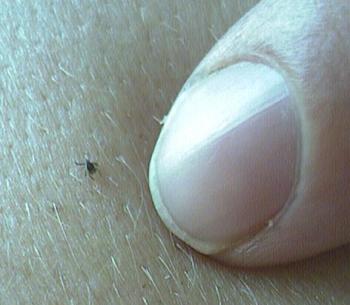
One thing we've noticed whilst out in the hills this summer is that the number of ticks is on the rise. A tick bite can be potentially deadly and so it's important to be aware of the risks and know what to do about them.
Ticks are small arachnids that live off the blood of other animals. They carry diseases, such as Lyme's Disease, which they can pass on to you if they bite you. They thrive in warmer weather and are a threat between March and October, and are most often found in areas of long grass, bracken and woodland.
Why are ticks dangerous?
Ticks can carry many different diseases. Lyme's disease is one such disease, which can cause symptoms such as 'flu, facial palsy, viral-type meningitis, arthritic-like joint pains, nerve inflammation and clumsiness, to name but a few. A bulls-eye rash (red ring-shaped area spreading from where the tick bit) is common sign you're infected, but this doesn't always appear. If you think you're infected, go to your GP immediately and tell them so.
Another disease is Tick Borne Encephalitis (TBE), which attacks the nervous system and can lead to severe meningitis, brain inflammation and death. Symptoms include a fever, neck stiffness and severe headaches.
How to remove ticks
Ticks bury their head into your flesh and so it's important to remove them properly to prevent leaving behind anything which may cause infection later. Squeezing the tick may also inject the infected blood back into you. Whatever you do, don't attempt to remove the tick by applying heat or chemicals such as vaseline.
- The best option is to use a specialist tick removal tool, which you can buy from most outdoor shops. These are typically a tweazer-like implement and come with full instructions how to use them.
- The next best option is to use a pair of tweazers, pulling upwards gently from the base of the tick and avoiding squeezing or crushing it.
- In the absense of the above, fingernails can be used: Slide your fingers towards the tick as if you were squeezing a spot, ensuring when they reach the tick they're not squeezing it or running over it, crushing it into your. You should be able to gently ease the tick out.
Top tips
Obviously, it's best to prevent get a tick bite in the first place, and here are some top tips to help you out:
- Wear long-sleeved tops and trousers if you know you're heading into tick-prone areas, such as long grassy and bracken. Tuck your trousers into your socks and t-shirt into your trousers; you might look silly but it's worth it!
- Brush down your clothes every so often to knock off any ticks that are trying to work their way to your skin. Wearing lighter coloured clothes makes it easier to spot ticks.
- Check your skin frequently.
- Spray yourself with insect repellent and the ticks will be less likely to bite. Spraying your clothes might help too, though this isn't recommeded if you have deet-based products as they can damage your clothes.
- Check yourself thoroughly when you return; ticks can get into all sorts of places and love the warmth, so make sure to check your armpits, groin, backs of legs and scalp.
Comments
There are no comments